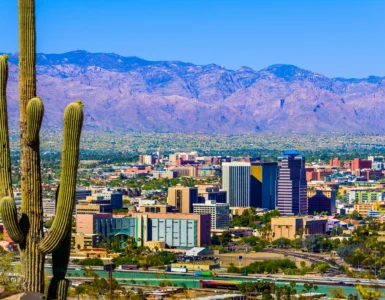Tucson-based Raytheon Missile Systems is Arizona’s largest defense contractor, conducting $4.4 billion in business annually, according to the Department of Defense.
“We are the world’s largest missile-maker,” said John Patterson, director of public relations for Raytheon Missile Systems, a division of Raytheon Company. “We’re involved in air-to-air missiles, air-to-ground missiles. We do tremendous work on the missile defense shield for the United States.”
Raytheon Missile Systems has about 15,000 employees worldwide, 13,000 of which are in Arizona. Raytheon has an estimated $2.1 billion annual impact on the Arizona economy, according to a 2017 analysis by Arizona State University.
“That’s through the work we do with suppliers — a network of suppliers around the state — that’s the wages, the salaries we pay, the taxes we pay,” Patterson said.
More than 500 suppliers statewide create parts for the weapons manufacturer, which leads its competitors by more than $2 billion in defense contract spending.
“They really are statewide, not just southern Arizona; Maricopa County has about half of our suppliers right in the Phoenix area,” Patterson said. “They’ll build subcomponents for us, and then we’ll assemble them on our plant site.”
Patterson said Raytheon prefers to hire locally, seeking engineers from Arizona universities. The company has added more than 2,000 workers in the past several years.
“As the workforce gets older, as people retire, we need those young minds, those excited innovators, to come along and dream up solutions that we never thought of,” Patterson said.
Over the past 10 to 12 years, Raytheon has contributed millions of dollars to science, technology, engineering and math (STEM) education, he said.
“We know that other countries are graduating more engineers annually than the United States, and we want to make sure that the country maintains its technological edge,” Patterson said. “Inspiring young people to choose STEM careers is vitally important in keeping the nation strong, but it also gives us a pipeline of talent.”
Along that talent pipeline, Raytheon volunteers thousands of hours each year tutoring young students in math and science, Patterson said. The company works with the state universities — ASU, Northern Arizona University and the University of Arizona — to expand partnerships and develop a successful workforce, he said.
“We also have a sharp focus on warfighter support,” he said. “When men and women in uniform are done with their service and are looking to integrate into civilian life, we are involved with helping with career counseling, showing them how their military experience could translate into corporate America.”
The company works with veterans who have emotional or physical injuries to help them rebuild their lives when they return from battle, Patterson said.
“We are in the middle of a major expansion; we are hiring,” he said. “Our expansion isn’t limited to employees. Business is good, so we are building new infrastructure.”
Last year, Gov. Doug Ducey joined Raytheon in a ribbon cutting as the company completed Phase I of its expansion; it is now working on Phase II, which includes hiring thousands more workers and building additional infrastructure.
“We put a lot of horsepower, if you will, into Arizona’s economy, and we’re growing,” Patterson said. “We are really proud of our position as one of the largest employers in the state of Arizona.”
Raytheon’s mission is to “innovate the future” and provide solutions for U.S. military servicemen and women to more effectively defend the country with next-generation technology. Most recently, Raytheon Missile Systems unveiled its new hypersonic weapons program in Tucson, where it is developing missiles that travel at speeds of Mach V (about 3,800 miles per hour) or greater.
“[The missiles travel at] incredibly fast speeds, and those are going to be needed in order to keep the country strong and to keep us ahead of our adversaries worldwide,” Patterson said. “We’re also harnessing what we call ‘directed energy’ — lasers or microwave energy — to use that to eliminate the threat of unmanned aircraft. The number of enemy drones that are proliferating the skies above the battlefield continues to grow, and it’s a huge threat to our soldiers on the ground.”
Raytheon’s directed energy technology harnesses microwave energy — “like your microwave oven, only a million times more powerful” — to disrupt guidance systems on small drones that may drop explosives on U.S. soldiers.
“This continues to be a problem and a huge challenge for the Department of Defense — how to protect our soldiers from the growing number of enemy drones,” Patterson said.
Raytheon is also developing “multi-mission” missiles that can serve various functions depending on the software onboard. Patterson said the company works closely with other aerospace and defense contractors in the state, in the name of national security.
“We team with many companies, like Boeing and Northrop [Grumman] and Lockheed Martin, on programs and products,” Patterson said. “We see the relationship as collaborative in many, many cases. They are our teammates working toward a common goal, and that is giving our men and women the very best product possible.”
Raytheon Missile Systems is not a “platform house,” meaning it does not build ships, planes, tanks or other defense vehicles, but it equips those platforms with advanced weaponry.
“If Boeing or Lockheed make a fighter jet, chances are, on the wing of those fighter aircraft are Raytheon weapons,” Patterson said. “When you think about it, a fighter aircraft… needs the products that we make so that it can be as effective as it is.”
Raytheon has had a presence in Arizona for more than 60 years and is “deeply committed to the state,” he said.
“It is our home, and there’s a great workforce,” Patterson said. “The governor has insisted on creating an environment that is very business-friendly. We’ve continued to prosper here, and as a result, Arizona prospers as we prosper. It’s been a win-win.”
















Add comment